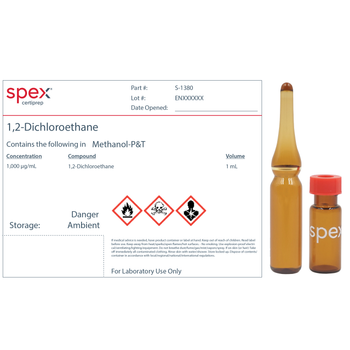Description
1,2-Dichloroethane
ACS reagent, ≥99.0%
Synonym(s):
Ethylene chloride, Ethylene dichloride
Linear Formula:
ClCH2CH2Cl
CAS Number:
107-06-2
Molecular Weight:
98.96
Beilstein:
605264
EC Number:
203-458-1
MDL number:
MFCD00000963
eCl@ss:
39050106
PubChem Substance ID:
329753938
NACRES:
NA.21
PROPERTIES
grade
ACS reagent
Quality Level
200
vapor density
3.4 (20 °C, vs air)
vapor pressure
87 mmHg ( 25 °C)
Assay
≥99.0%
form
liquid
autoignition temp.
775 °F
expl. lim.
15.6 %
impurities
≤0.0003 meq/g Titr. acid
≤0.03% water
evapn. residue
≤0.002%
color
APHA: ≤10
clear
refractive index
n20/D 1.444 (lit.)
bp
83 °C (lit.)
mp
−35 °C (lit.)
density
1.256 g/mL at 25 °C (lit.)
SMILES string
ClCCCl
InChI
1S/C2H4Cl2/c3-1-2-4/h1-2H2
InChI key
WSLDOOZREJYCGB-UHFFFAOYSA-N
DESCRIPTION
General description
1,2-Dichloroethane (ethylene dichloride, DCE) is a solvent. It is one of the degradation by-product released from vinyl chloride manufacturing industries (EDC-tar). Its mutagenic activity has been tested on Salmonella typhimurium TA 1535.[1] Its catalytic degradation over titania/silica (acid catalysts) has been investigated.[2]
Application
1,2-Dichloroethane (ethylene dichloride, DCE) may be used in the following studies:
- As electron acceptor in the culture medium of Dehalococcoides ethenogenes 195.[3]
- As model compound for chlorinated organics in various studies.[3]
- Chemical doping during the fabrication of Cl-doped few-layer WS2 or MoS2 back gate field-effect transistors (FETs).[4]
SAFETY INFORMATION
Signal Word
Danger
Hazard Statements
H225 - H302 - H304 - H315 - H319 - H331 - H335 - H350
Precautionary Statements
P210 - P301 + P310 - P303 + P361 + P353 - P304 + P340 + P311 - P305 + P351 + P338 - P331
Hazard Classifications
Acute Tox. 3 Inhalation - Acute Tox. 4 Oral - Asp. Tox. 1 - Carc. 1B - Eye Irrit. 2 - Flam. Liq. 2 - Skin Irrit. 2 - STOT SE 3
Target Organs
Respiratory system
Storage Class Code
3 - Flammable liquids
WGK
WGK 3
Flash Point(F)
55.4 °F - closed cup
Flash Point(C)
13 °C - closed cup





